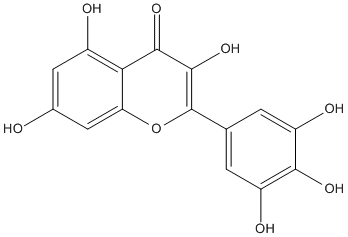Myricetin
Myricetin is a naturally-occurring flavonoid found in many grapes, berries, fruits, vegetables, herbs
General
Type : Natural,Flavonoid
Chemical_Nomenclature : 3,5,7-trihydroxy-2-(3,4,5-trihydroxyphenyl)chromen-4-one
Canonical SMILES : C1=C(C=C(C(=C1O)O)O)C2=C(C(=O)C3=C(C=C(C=C3O2)O)O)O
InChI : InChI=1S\/C15H10O8\/c16-6-3-7(17)11-10(4-6)23-15(14(22)13(11)21)5-1-8(18)12(20)9(19)2-5\/h1-4,16-20,22H
InChIKey : IKMDFBPHZNJCSN-UHFFFAOYSA-N
Other name(s) : Cannabiscetin,Myricetol,Myricitin,CHEBI:18152,ChEMBL164
MW : 318.23
Formula : C15H10O8
CAS_number :
PubChem : 5281672
UniChem : IKMDFBPHZNJCSN-UHFFFAOYSA-N
IUPHAR :
Wikipedia :

Target
References (2)
| Title : Inhibition of CpLIP2 Lipase Hydrolytic Activity by Four Flavonols (Galangin, Kaempferol, Quercetin, Myricetin) Compared to Orlistat and Their Binding Mechanisms Studied by Quenching of Fluorescence - Nasri_2019_Molecules_24_ |
| Author(s) : Nasri R , Bidel LPR , Rugani N , Perrier V , Carriere F , Dubreucq E , Jay-Allemand C |
| Ref : Molecules , 24 : , 2019 |
| Abstract : Nasri_2019_Molecules_24_ |
| ESTHER : Nasri_2019_Molecules_24_ |
| PubMedSearch : Nasri_2019_Molecules_24_ |
| PubMedID: 31398944 |
| Gene_locus related to this paper: canpa-LIP2 |
| Title : Myricetin ameliorates scopolamine-induced memory impairment in mice via inhibiting acetylcholinesterase and down-regulating brain iron - Wang_2017_Biochem.Biophys.Res.Commun_490_336 |
| Author(s) : Wang B , Zhong Y , Gao C , Li J |
| Ref : Biochemical & Biophysical Research Communications , 490 :336 , 2017 |
| Abstract : Wang_2017_Biochem.Biophys.Res.Commun_490_336 |
| ESTHER : Wang_2017_Biochem.Biophys.Res.Commun_490_336 |
| PubMedSearch : Wang_2017_Biochem.Biophys.Res.Commun_490_336 |
| PubMedID: 28619513 |